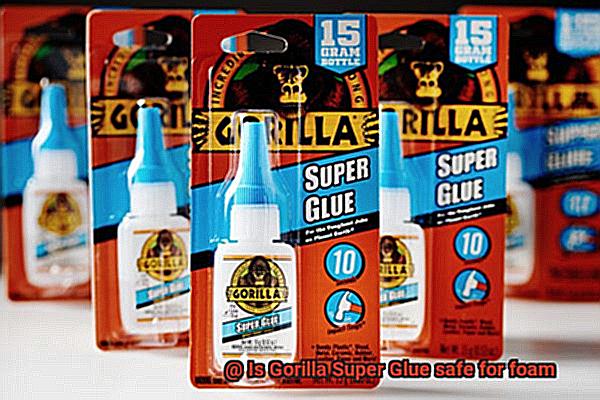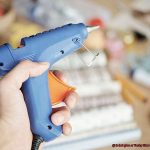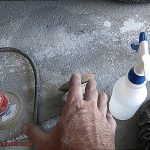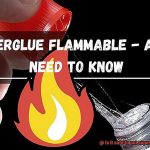Picture this: you’re in the midst of creating a work of art. You’ve got your design down pat, chosen the ideal foam materials, and are all set to glue everything together. But then comes the big question – is Gorilla Super Glue safe for foam? Don’t fret, we’ve got your back.
Gorilla Super Glue is a well-known adhesive that’s used in DIY, crafting, and home repair projects globally. It’s famous for its strength and ability to bond nearly any surface. However, when it comes to foam materials, it’s crucial to understand the safety implications of using this adhesive.
In this blog post, we’ll cover all the safety precautions and best practices for using Gorilla Super Glue with foam materials. We’ll address common concerns that arise when super glue meets foam – such as potential chemical reactions and their effects on foam material.
By the end of this post, you’ll have a clear understanding of whether or not Gorilla Super Glue is safe to use with foam. And most importantly, you’ll know what steps to take to ensure your crafting experience remains both safe and enjoyable.
Different Types of Foam and Their Properties
Contents
- 1 Different Types of Foam and Their Properties
- 2 Is Gorilla Super Glue Suitable for Foam?
- 3 Testing the Adhesive on a Small Area
- 4 Bonding Open-Cell and Closed-Cell Foams with Gorilla Super Glue
- 5 Precautions to Take When Using Gorilla Super Glue on Foam
- 6 Cleaning Up Excess Gorilla Super Glue from Foam
- 7 Potential Hazards of Using the Wrong Type of Adhesive on Foam
- 8 Benefits of Using Gorilla Super Glue on Foam
- 9 Conclusion
Foam is a versatile material that serves a wide range of applications, from insulation and packaging to upholstery and cushions. There are various types of foam available, each with unique properties and characteristics that make them suitable for specific uses. In this article, we will delve deeper into the different types of foam and how they can impact the type of adhesive used.
Polyurethane Foam
Polyurethane foam is a popular type of foam that is synthetic, lightweight, and durable. It has excellent resilience, which means that it can quickly bounce back into shape after being compressed.
Polyurethane foam is commonly found in furniture cushions, mattresses, and car seats. When bonding polyurethane foam, it’s best to use specialized adhesives like contact adhesive or hot glue gun because they are formulated to provide a strong bond while also being flexible enough to withstand stress and movement.
Polystyrene Foam
Polystyrene foam is rigid and often used in packaging materials and insulation due to its lightweight properties and excellent thermal insulation properties. However, polystyrene foam can be dissolved by some adhesives; hence it’s crucial to choose an adhesive that won’t dissolve or deform the foam when bonding it.
Closed-Cell Foam
Closed-cell foam is a waterproof type of foam commonly used in the marine industry because it’s highly resistant to chemicals and UV radiation. It’s perfect for boats and other watercraft. However, before using an adhesive on closed-cell foam, it’s crucial to test a small area first to ensure compatibility.
Gorilla Super Glue
Gorilla Super Glue is a popular cyanoacrylate-based adhesive that is known for its strong bond and fast-drying time. Although it can bond to a variety of surfaces, it may not be the best option for bonding foam since cyanoacrylate adhesives can be brittle and may not hold up well under stress or flexing, which can be an issue when bonding foam.
Choosing the Right Adhesive
When selecting an adhesive for foam, it’s essential to consider the type of foam being used and the intended use of the foam and adhesive. It’s also important to test a small area first before applying larger amounts of glue.
Specialized adhesives designed for foam bonding, such as contact adhesive or hot glue gun, are formulated to provide a strong bond while also being flexible enough to withstand stress and movement.

In conclusion, understanding the properties of different types of foam is crucial when selecting the right adhesive.
Is Gorilla Super Glue Suitable for Foam?
The question remains: is it suitable for foam materials?
The answer is not straightforward and depends on a few factors. Gorilla Super Glue is known for its strong bonding properties and fast drying time, but it can also be quite rigid once it dries. This rigidity may not be ideal for certain types of foam, such as soft foam materials like upholstery or memory foam. In these cases, Gorilla Super Glue could cause the foam to become too stiff, losing its cushioning properties.
However, if you’re working with rigid foam materials such as polystyrene or foam board, Gorilla Super Glue may be a suitable option. But don’t take our word for it. Always test the glue on a small inconspicuous area first to ensure there are no adverse effects.
When applying Gorilla Super Glue on foam, it’s important to use the glue sparingly and apply it in a thin layer. This technique ensures that the glue doesn’t saturate the foam, causing it to lose its shape or structure. Additionally, apply the glue to one surface first and then press the two surfaces together to avoid over-saturating the foam.
Testing the Adhesive on a Small Area
Not all adhesives are created equal, and you certainly don’t want to risk damaging your precious foam materials.
To test Gorilla Super Glue on foam, start by choosing an inconspicuous area. Apply a small amount of the glue and press it down firmly. Allow it to dry completely as per the manufacturer’s instructions. Once dry, give the glued area a thorough inspection for any signs of damage or discoloration.
But the real test comes when you try to separate the glued area from the foam. Give it a gentle tug and see if the bond is strong enough for your intended use. This simple step can save you from a lot of frustration and heartache down the line.
It’s important to note that not all Gorilla Super Glue formulations are created equal either. For porous surfaces like foam, Gorilla Super Glue Gel may be a better choice than the standard variety. So choose wisely.
Bonding Open-Cell and Closed-Cell Foams with Gorilla Super Glue
As an expert in foam bonding, I’m here to share my knowledge on how to create a strong, permanent bond using Gorilla Super Glue.
First, it’s essential to understand the properties of both open-cell and closed-cell foams. Open-cell foam is denser and more porous than closed-cell foam, which has a lower density and is less porous. Knowing these differences is crucial when it comes to selecting the right adhesive.
Before using Gorilla Super Glue on foam, always test it on a small, inconspicuous area first. This step will help you determine if the glue causes any damage or discoloration to the foam. If all is well, you can proceed with bonding the foam.
To bond open-cell foam with Gorilla Super Glue, apply a small amount of glue to one surface and press the two surfaces together firmly. Hold them in place for at least 10-30 seconds until the glue sets. However, when it comes to closed-cell foam, it’s best to use a two-part epoxy adhesive as it creates a stronger bond.
Temperature is another critical factor to consider when bonding foam with Gorilla Super Glue. The ideal temperature for using this glue is between 70-80 degrees Fahrenheit. If the temperature is too low, the glue may take longer to set or not set at all. If the temperature is too high, the glue may dry too quickly and not create a strong bond.
Finally, always use Gorilla Super Glue in a well-ventilated area and avoid skin contact. If skin contact does occur, rinse the affected area with warm water and soap.
Precautions to Take When Using Gorilla Super Glue on Foam
Before you get started, it’s essential to take precautions to ensure safety and prevent any damage to the foam surface. As an expert in this field, I have some key tips to keep in mind.
Firstly, make sure your workspace is well-ventilated. Gorilla Super Glue emits fumes that can be dangerous if inhaled in large quantities. If you’re unable to work in a well-ventilated area, protect yourself by wearing a mask to avoid breathing in the fumes.
Secondly, always wear gloves when working with Gorilla Super Glue on foam. This glue can stick to your skin quickly and prove challenging to remove, so protect your hands with gloves to avoid accidental contact.
Before applying Gorilla Super Glue to a large foam surface, test it out on a small area first. This step will allow you to see how the glue reacts with the foam and ensure it doesn’t cause any damage or discoloration.
When applying Gorilla Super Glue to foam, use it sparingly. Applying too much glue can cause the foam to become brittle and potentially break apart. Additionally, avoid using this glue on thin or delicate foam surfaces as it can cause damage or even dissolve the foam.
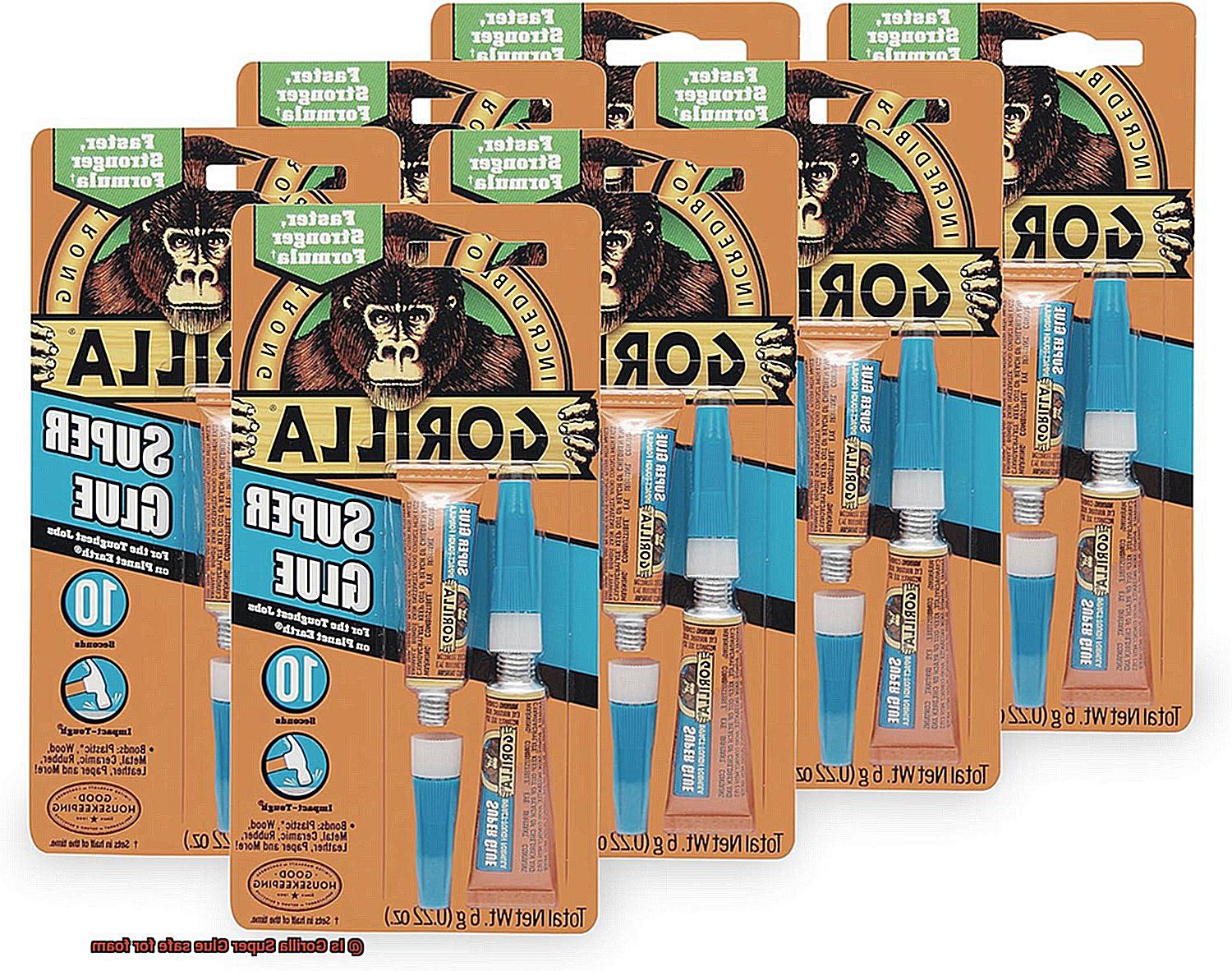
Cleaning Up Excess Gorilla Super Glue from Foam
There are effective methods to safely and efficiently clean it up. As an expert in the field, I have compiled some helpful tips and tricks for removing excess glue without causing damage to your foam surface.
Before delving into the cleaning process, it’s important to take precautions when using Gorilla Super Glue on foam. Wearing gloves and working in a well-ventilated area can prevent accidents and damage. Additionally, testing the glue on a small area before applying it to larger surfaces is recommended.
One of the most effective methods for removing excess Gorilla Super Glue from foam is using acetone. However, it’s essential to note that acetone is a potent solvent that can damage some types of foam. To use acetone safely, follow these steps:
- Protect your hands with gloves before handling acetone.
- Apply a small amount of acetone to a cotton swab or soft cloth.
- Gently rub the affected area until the excess glue starts to dissolve.
- Keep rubbing until all the excess glue has been removed.
Use a clean and dry cloth to wipe away any remaining residue.
If you’re concerned about using acetone on your foam surface, another option is rubbing alcohol. Rubbing alcohol is also a solvent that can dissolve super glue and make it easier to remove. Follow these steps when using rubbing alcohol:
- Wear gloves to protect your hands from rubbing alcohol.
- Apply a small amount of rubbing alcohol to a cotton swab or soft cloth.
- Gently rub the affected area until the excess glue starts to dissolve.
- Continue rubbing until all the excess glue has been removed.
Use a clean and dry cloth to wipe away any remaining residue.
However, it’s important to note that like acetone, rubbing alcohol can also damage some types of foam. Therefore, testing it on a small, inconspicuous area first is recommended.
Potential Hazards of Using the Wrong Type of Adhesive on Foam
Foam is a wonder material that has found its way into various applications, from art and craft to insulation and cushioning. However, when it comes to adhesion, not all glues are created equal. Using the wrong type of adhesive on foam can lead to several potential hazards that can be detrimental to both the foam and its user.
Firstly, using unsuitable adhesives can cause the foam to deteriorate or break down over time. Certain chemicals present in adhesives can react with foam, making it weaker and even brittle. This can result in a loss of shape or structural integrity, which can be hazardous if the foam is used for protection or insulation purposes.
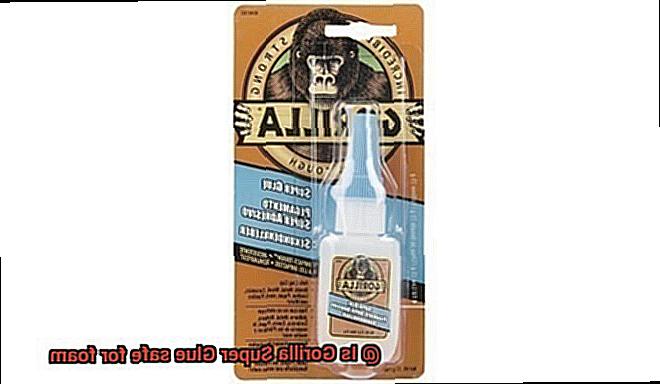
Secondly, some adhesives release harmful fumes or chemicals into the air. This can pose a significant risk to both the user and anyone nearby. If the foam is used in an enclosed space like a vehicle or a room, these fumes can accumulate and cause severe health problems.
Furthermore, using an incorrect adhesive can weaken the bond between the foam and the surface it is attached to. This can cause the foam to shift or detach over time, which can be problematic if it is being used for cushioning or insulation.
To avoid these hazards, always ensure that you choose the right adhesive for your project. Check the manufacturer’s instructions and recommendations before using any adhesive on foam. Remember that Gorilla Super Glue may not be safe for use on all types of foam.
Benefits of Using Gorilla Super Glue on Foam
Foam materials have become increasingly popular in various industries due to their versatility and lightweight properties. Whether you’re working on a DIY craft project or repairing foam materials, choosing the right adhesive is essential to ensure a strong and long-lasting bond.
And that’s where Gorilla Super Glue comes in – this adhesive offers numerous benefits when used on foam materials, making it a game-changer in the world of adhesives.
One of the most significant benefits of using Gorilla Super Glue on foam is its strong and durable bond that can withstand a wide range of conditions. This adhesive creates a tight and secure hold that can withstand wear and tear, making it ideal for foam materials that need to be robust. Unlike other types of glue that may weaken over time, Gorilla Super Glue offers a bond that lasts for a long time.
Another benefit of using Gorilla Super Glue on foam is its fast-drying properties. This adhesive dries quickly, allowing you to work efficiently and complete your project in no time. This is particularly useful when working with large or complex foam pieces that require multiple applications of glue. Additionally, Gorilla Super Glue comes with an easy-to-use precision tip that allows you to apply the glue precisely where you need it.
Gorilla Super Glue is also waterproof, which makes it ideal for use on foam materials that are frequently exposed to moisture or humidity, such as outdoor settings or environments where they may come into contact with water or other liquids. This adhesive’s waterproof properties ensure that your bond remains strong even in damp conditions.
The versatility of Gorilla Super Glue is another advantage when it comes to adhering foam materials. You can use this adhesive on different types of foam materials, including foam sheets, blocks, and balls. Its long shelf life means that you can store it for extended periods without worrying about it drying out or losing its effectiveness.
kg7Z8m5rSjY” >
Conclusion
In conclusion, Gorilla Super Glue has gained popularity as a go-to adhesive for DIY enthusiasts and professionals alike. However, when it comes to foam materials, caution is essential. Foam is a versatile material that serves various purposes, from insulation and packaging to upholstery and cushions.
With different types of foam available in the market, each with unique properties and characteristics that make them suitable for specific uses, selecting the right adhesive is crucial.
When choosing an adhesive for foam, it’s vital to consider the type of foam being used and its intended use. It’s also important to test a small area first before applying larger amounts of glue. Specialized adhesives designed for foam bonding like contact adhesive or hot glue gun provide a strong bond while also being flexible enough to withstand stress and movement.
While Gorilla Super Glue may be suitable for bonding rigid foam materials such as polystyrene or foam board, it may not be ideal for soft foam materials like upholstery or memory foam due to its rigidity once dried. When using Gorilla Super Glue on foam, apply it sparingly in thin layers. Always test the glue on a small inconspicuous area before using it on larger surfaces.
In summary, understanding the properties of different types of foam is crucial when selecting the right adhesive. Taking precautions when using Gorilla Super Glue on foam can prevent accidents and damage while ensuring a strong and long-lasting bond.

